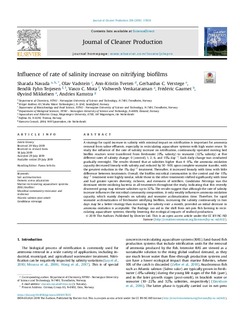| dc.contributor.author | Navada, Sharada | |
| dc.contributor.author | Vadstein, Olav | |
| dc.contributor.author | Tveten, Ann-Kristin | |
| dc.contributor.author | Verstege, Gerhardus C. | |
| dc.contributor.author | Terjesen, Bendik Fyhn | |
| dc.contributor.author | Mota, Vasco C. | |
| dc.contributor.author | Venkataraman, Vishwesh | |
| dc.contributor.author | Gaumet, Frederic | |
| dc.contributor.author | Mikkelsen, Øyvind | |
| dc.contributor.author | Kamstra, Andries | |
| dc.date.accessioned | 2019-08-09T07:29:07Z | |
| dc.date.available | 2019-08-09T07:29:07Z | |
| dc.date.created | 2019-08-02T08:55:22Z | |
| dc.date.issued | 2019 | |
| dc.identifier.issn | 0959-6526 | |
| dc.identifier.uri | http://hdl.handle.net/11250/2607684 | |
| dc.description.abstract | A strategy for rapid increase in salinity with minimal impact on nitrification is important for ammonia removal from saline effluents, especially in recirculating aquaculture systems with high water reuse. To study the influence of the rate of salinity increase on nitrification, continuously operated moving bed biofilm reactors were transferred from freshwater (0‰ salinity) to seawater (32‰ salinity) at five different rates of salinity change: 0 (control), 1, 2, 6, and 15‰ day−1. Each daily change was conducted gradually overnight. The results showed that at salinities higher than 4–8‰, the ammonia oxidation capacity decreased linearly with salinity and reduced by 50–90% upon complete seawater transfer, with the greatest reduction in the 1‰ day−1 treatment. Thereafter, it increased linearly with time, with little difference between treatments. Overall, the biofilm microbial communities in the control and the 15‰ day−1 treatment were highly similar, while those in the other treatments shifted significantly with time and had greater species diversity, richness, and evenness of nitrifiers. Candidatus Nitrotoga was the dominant nitrite oxidizing bacteria in all treatments throughout the study, indicating that this recently discovered group may tolerate salinities up to 32‰. The results suggest that although the rate of salinity increase influences the microbial community composition, it only weakly influences ammonia oxidation capacity, which mainly depends on salinity and seawater acclimatization time. Therefore, for rapid seawater acclimatization of freshwater nitrifying biofilms, increasing the salinity continuously in two days may be a better strategy than increasing the salinity over a month, provided an initial decrease in ammonia oxidation is acceptable. The findings can aid in the shift from net-pen fish farming to recirculating aquaculture systems, thereby lowering the ecological impacts of seafood production. | nb_NO |
| dc.language.iso | eng | nb_NO |
| dc.publisher | Elsevier | nb_NO |
| dc.rights | Attribution-NonCommercial-NoDerivatives 4.0 Internasjonal | * |
| dc.rights.uri | http://creativecommons.org/licenses/by-nc-nd/4.0/deed.no | * |
| dc.title | Influence of rate of salinity increase on nitrifying biofilms | nb_NO |
| dc.type | Journal article | nb_NO |
| dc.type | Peer reviewed | nb_NO |
| dc.description.version | publishedVersion | nb_NO |
| dc.source.journal | Journal of Cleaner Production | nb_NO |
| dc.identifier.doi | https://doi.org/10.1016/j.jclepro.2019.117835 | |
| dc.identifier.cristin | 1713740 | |
| dc.relation.project | Norges forskningsråd: 237856 | nb_NO |
| dc.relation.project | Norges forskningsråd: 270888 | nb_NO |
| dc.description.localcode | © 2019 The Authors. Published by Elsevier Ltd. This is an open access article under the CC BY-NC-ND license (http://creativecommons.org/licenses/by-nc-nd/4.0/) | nb_NO |
| cristin.unitcode | 194,66,25,0 | |
| cristin.unitcode | 194,66,15,0 | |
| cristin.unitcode | 194,66,45,0 | |
| cristin.unitname | Institutt for kjemi | |
| cristin.unitname | Institutt for bioteknologi og matvitenskap | |
| cristin.unitname | Institutt for biologiske fag Ålesund | |
| cristin.ispublished | false | |
| cristin.fulltext | postprint | |
| cristin.qualitycode | 2 | |

